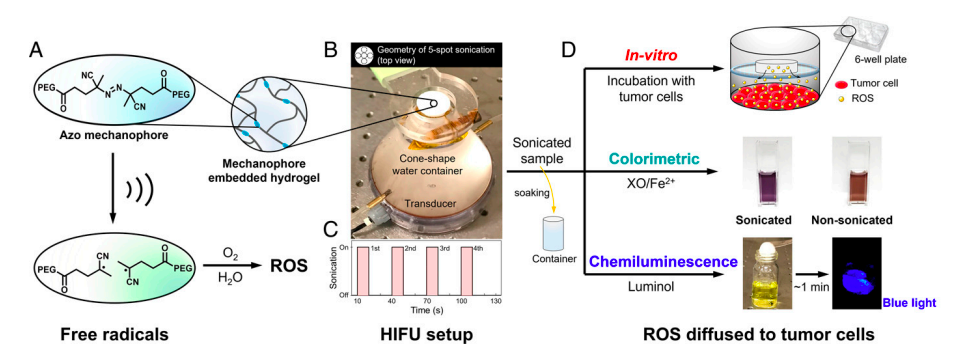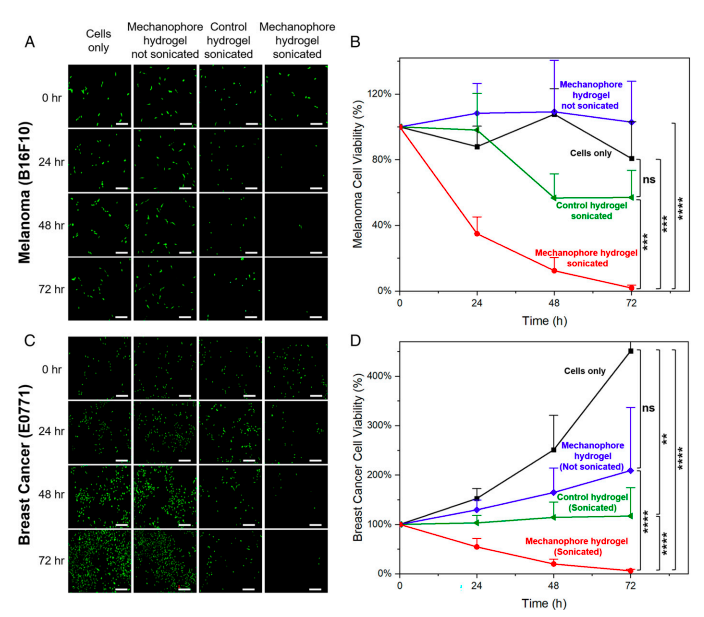A joint research team, affiliated with UNIST has reported that they have successfully developed a novel tool for cancer treatment, utilizing therapeutic ultrasound. According to the research team, the new method has also proved surprisingly effective in animal tests, thereby demonstrating its potential as a platform for cancer treatment.
Published in the January 2022 issue of the Proceedings of the National Academy of Sciences (PNAS), this breakthrough has been led by Professor Gun Kim in the Department of Urban and Environmental Engineering at UNIST, in collaboration with researchers at the University of Illinois Urbana-Champaign in the United States.

Figure 1. (A) The structure of the azo-based mechanophore hydrogel for the generation of FRs and ROS under sonication. (B) The sonication setup. (C) The sonication cycles (four repetitions for each spot). (D) The detection of ROS and in vitro treatment.
In the study, the research team provided a demonstration that ROS-generating mechanophores in hydrogels are of interest in a biomedical context, particularly having potential for noninvasive cancer therapy.
Using azo-based mechanophores in a biocompatible polyethylene glycol (PEG) hydrogel, coupled with the high-intensity focused ultrasound (HIFU), the research team developed a cancer therapy platform, MDT, enabling the targeted release of reactive oxygen species (ROS).
According to the research team, the nonactivated azo mechanophore hydrogels resulted in no cytotoxicity due to good thermostability, while upon HIFU sonication, they rapidly generate reactive FRs and ROS to kill tumor cells in a non-invasive manner. With these advances, MDT achieves therapeutic efficacy of ∼100% within 72 h in vitro tumor models, including melanoma (B16F10) and breast cancer models (E0771), which is comparable with a lethal dosage of H2O2.

Figure 2. Fluorescence images and quantification of live tumor cells before (0 hr) and after (24 to 72 hr) MDT (sonicated control and mechanophore hydrogel) compared with controls (cells only and nonsonicated mechanophore hydrogel) for melanoma (A and B) and breast cancer (C and D).
The research team also plans on conducting additional studies to remove cancer cells from the body of living animals.
"Taking advantage of the strengths of mechanophores and HIFU, MDT can provide non-invasive treatments for diverse cancer types," said Professor Kim.
Professor Kim, who joined UNIST in 2020, has been working tirelessly to advance multi-disciplinary knowledge at the crossroads between ultrasonics, dynamics/mechanics, polymer chemistry, and bioengineering, with the particular goal of developing a new sensing material that can seamlessly interact with structures and environments. Recent works include the development of smart materials that can be strong and self-sensing for structural health monitoring.
Meanwhile, this research has been jointly participated by researchers from UIUC in the United States, which include Jeffrey S. Moore, King C. Li, and Michael L. Oelze. It has been carried out with the support of the National Institute of Health and the 2020 Research Fund of UNIST.
Journal Reference
Gun Kim, Qiong Wu, James L. Chu, et al., "Ultrasound controlled mechanophore activation in hydrogels for cancer therapy," PNAS, (2022).






